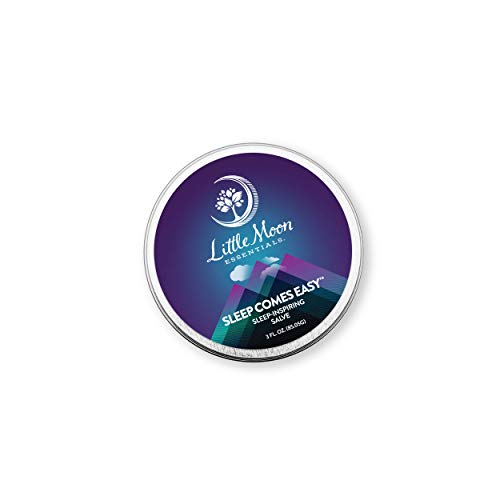

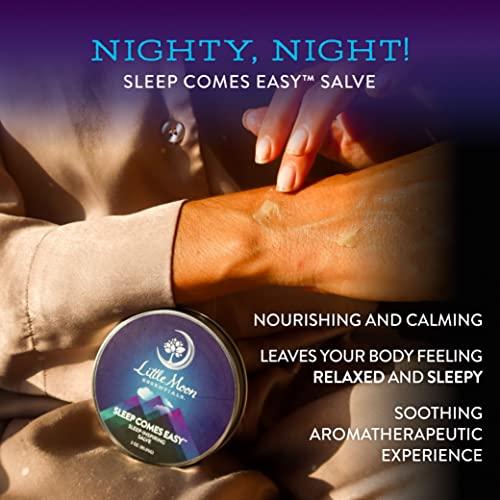
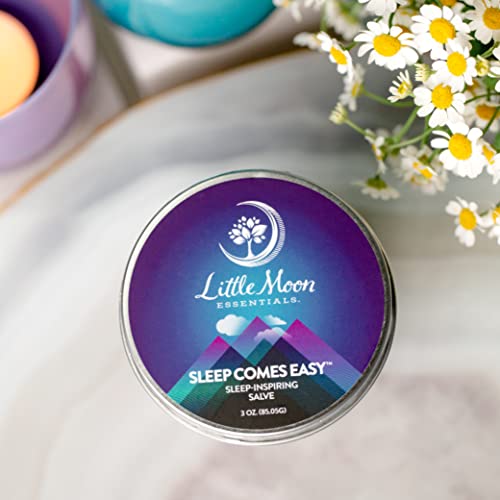
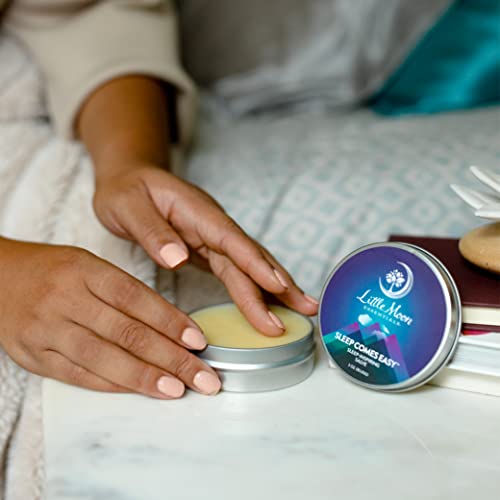
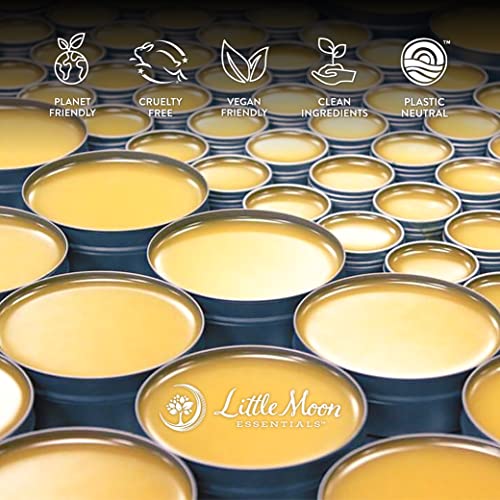
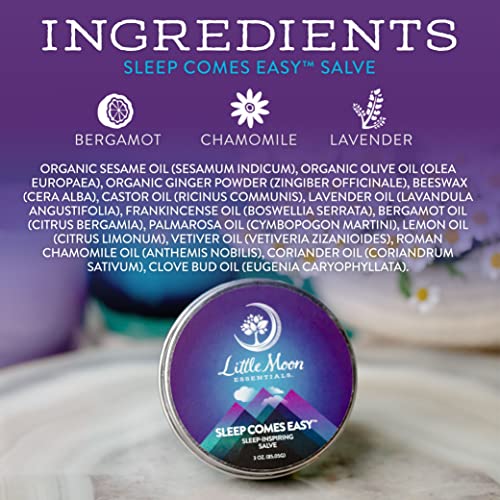
Little Moon Essentials Aromatherapy Salve - Promotes Restful Sleep, Vegan & Natural - 3oz


Eugenia Caryophyllus (Clove) Oil
High RiskEugenia caryophyllus (clove) oil is an essential oil derived from the flower buds of the clove tree. It is primarily used for its aromatic properties and as a flavoring agent in food and beverages. Additionally, it is utilized for its potential therapeutic benefits in various cosmetic and medicinal applications.
Sustai Insights
Clove oil offers functional benefits, including antimicrobial properties and flavor enhancement, with some sustainability credentials due to its natural sourcing. However, it has a high allergenic potential and poses risks of skin irritation. Regulatory agencies advise caution in use due to these health risks. Clove oil is restricted in certain formulations, leading to an overall high-risk assessment. Safe usage practices are essential, and alternatives such as cinnamon or other essential oils may be considered.
Cymbopogon Martini (Palmarosa)
High RiskCymbopogon martini, commonly known as palmarosa, is a grass native to India and is primarily used for its essential oil, which serves as a fragrance and potential antibacterial agent in cosmetic formulations.
Sustai Insights
Palmarosa oil offers functional benefits including its use as a natural fragrance and potential antimicrobial properties. However, it has a high allergenic potential, posing risks of skin irritation and sensitization. Environmentally, it may not be significantly hazardous, but concerns about its cultivation practices exist. Regulatory bodies place some restrictions on its use, leading to an overall high risk assessment. Safe usage practices should be followed, and consideration for alternatives such as lavender or geranium oils may provide safer options.
Anthemis Nobilis (Chamomile)
High RiskAnthemis nobilis, commonly known as chamomile, is derived from the flowering plant of the same name. It is often used in various preparations for its soothing properties and is commonly included in personal care products for its potential calming effects on the skin.
Sustai Insights
Chamomile offers functional benefits such as skin soothing and anti-inflammatory properties. However, it carries a high allergenic potential, posing risks for individuals with sensitivities. Environmental concerns include low neurotoxicity and minimal pollution risk. Regulatory bodies have noted restrictions on its use. Overall, the ingredient is assessed to have a high risk due to these factors, especially concerning allergic reactions.
Coriandrum Sativum (Coriander) Oil
High RiskCoriandrum sativum (coriander) oil is derived from the fruit of the coriander plant. It is commonly used for its aromatic properties and as a flavoring agent in various products. In cosmetics and personal care, it serves as a fragrance and may offer skin-soothing benefits.
Sustai Insights
Coriander oil provides functional benefits as a fragrance and potential skin-soothing agent. However, it carries a high risk of allergies and skin irritation, while being low in concerns for carcinogenicity and reproductive toxicity. Environmental risks include moderate persistence and bioaccumulation. Regulatory restrictions apply, with advisories from the FDA and environmental agencies. Overall, the ingredient is assessed as high risk, necessitating caution in usage, especially for individuals with sensitivities. Alternatives like chamomile or lavender oils may be considered for safer formulations.
Lavandula Angustifolia (Lavender)
High RiskLavandula angustifolia, commonly known as lavender, is an unspecified preparation derived from the lavender plant, primarily utilized for its aromatic properties in various cosmetic and personal care products. It is recognized for its potential role in fragrance formulation and may also possess mild soothing properties.
Sustai Insights
Lavender offers functional benefits as a fragrance ingredient and may have mild calming effects. However, it is associated with a high allergenic potential, posing risks of skin irritation or allergic reactions. Regulatory bodies do not impose significant restrictions, but the ingredient is not currently listed on skin sensitizers. Overall, the ingredient carries a high risk profile, particularly for individuals with sensitivities. Safe usage practices should be observed, with consideration for alternatives like synthetic fragrances that may reduce allergenic responses.
Citrus Aurantium Bergamia (Bergamot) Fruit Oil
High RiskCitrus aurantium bergamia (bergamot) fruit oil is a volatile oil extracted from the fruit of the bergamot orange. It is commonly used in various cosmetic and fragrance products for its aromatic properties.
Sustai Insights
Bergamot oil serves as a fragrant compound with potential benefits in aromatherapy and personal care formulations. However, it is associated with high allergenic potential, with risks of skin irritation and phototoxicity. Regulatory agencies have noted usage restrictions due to these concerns. While the oil is not classified as a carcinogen, it presents moderate risks overall. Caution is advised for sensitive populations, and safer alternatives like sweet orange oil may be considered.
Ricinus Communis (Castor) Seed Oil
Medium RiskCastor oil is extracted from the seeds of Ricinus communis and is commonly used in cosmetic and personal care products for its moisturizing and emollient properties. It is known for its ability to enhance skin absorption and provide a protective barrier.
Sustai Insights
Castor oil offers functional benefits as a moisturizer and emollient, enhancing skin absorption and providing a barrier against moisture loss. It is sustainably sourced and biodegradable. However, potential health risks include low levels of irritation and moderate concerns regarding developmental and reproductive toxicity. Environmental risks are low, with no significant pollutant or bioaccumulation concerns reported. Regulatory status shows no current restrictions. Overall, the risk level is assessed as medium, with recommendations for safe usage practices, and potential alternatives include other plant-based oils.
Vetiveria Zizanioides Root Oil
Medium RiskVetiveria zizanioides root oil is a volatile oil derived from the roots of the vetiver plant. It is primarily used for its aromatic properties in perfumes and cosmetics, as well as for its potential therapeutic benefits in aromatherapy and traditional medicine.
Sustai Insights
Vetiveria zizanioides root oil offers functional benefits as a fragrance and may have calming effects in aromatherapy. It is generally considered low risk for carcinogenicity and developmental toxicity but poses moderate concerns for allergies. Environmentally, it is not known to be bioaccumulative, and its production is often sustainable. Regulatory statuses are favorable, with no current restrictions. Overall, while it has beneficial properties, the moderate allergy risk necessitates caution in sensitive populations, leading to a medium risk assessment.
Zingiber Officinale (Ginger) Root Extract
Low RiskZingiber officinale (ginger) root extract is derived from the ginger plant, widely recognized for its use in culinary applications and traditional medicine. It serves various functions in products, including flavor enhancement and potential therapeutic benefits due to its bioactive compounds.
Sustai Insights
Ginger root extract offers functional benefits such as flavoring and possible anti-inflammatory properties. It is sustainably sourced and biodegradable. Health risks are low, with minimal concerns regarding carcinogenicity, allergies, or reproductive toxicity. Environmental risks appear low, with no significant pollutants. Regulatory status is favorable, with no major warnings. Overall, the risk level associated with ginger root extract is low, making it a suitable ingredient in various applications.
Anthemis Nobilis (Chamomile) Flower Oil
Low RiskAnthemis nobilis, commonly known as chamomile flower oil, is extracted from the flowers of the chamomile plant. This essential oil is often used in cosmetic and personal care products for its soothing properties and fragrance.
Sustai Insights
Anthemis nobilis offers functional benefits such as skin soothing and anti-inflammatory properties, making it popular in skincare formulations. It is typically sustainably sourced and biodegradable. Health risks are generally low, with no significant concerns regarding carcinogenicity, allergies, or reproductive toxicity. Environmental risks are minimal, and regulatory status is favorable with few restrictions. The overall risk level is low, and safe usage practices include testing for sensitivity. Alternatives like calendula oil may provide similar benefits with a comparable safety profile.
Beeswax, Yellow
Low RiskBeeswax, yellow, is a natural wax produced by honeybees, primarily composed of esters of fatty acids and long-chain alcohols. It serves as an emulsifier, thickener, and stabilizer in cosmetic formulations, contributing to texture and consistency. It is commonly used in creams, balms, and lip products.
Sustai Insights
Beeswax provides functional benefits such as enhancing product texture and acting as a natural emulsifier, while also being biodegradable and sustainably sourced. Health risks are minimal, with low concerns for carcinogenicity, allergies, or irritations. Environmental impacts are also low, as it does not bioaccumulate. Regulatory status remains favorable with no current restrictions. Overall, the ingredient poses low risk, making it a suitable choice in cosmetic formulations.
Sesamum Indicum (Sesame) Oil
Low RiskSesamum indicum (sesame) oil is derived from the seeds of the sesame plant. It is commonly used in cosmetic formulations due to its emollient properties and ability to nourish the skin. This oil is rich in fatty acids and antioxidants, contributing to its effectiveness in various skincare products.
Sustai Insights
Sesame oil offers several functional benefits, including moisturization and nourishment for the skin, along with potential antioxidant properties. It is generally regarded as safe, with low concerns regarding carcinogenicity, allergies, and reproductive toxicity. Environmental risks are minimal, and the oil is not known to be bioaccumulative. Regulatory bodies do not impose significant restrictions on its use. Overall, sesame oil poses a low risk, making it a viable ingredient in cosmetic formulations, although consumers should consider potential allergies and choose responsibly sourced products.
Citrus Limon (Lemon) Peel
Low RiskCitrus limon (lemon) peel is derived from the outer skin of lemons and is commonly used in cosmetic formulations for its aromatic properties and potential skin benefits. It serves primarily as a fragrance agent and may also provide antioxidant effects.
Sustai Insights
Citrus limon (lemon) peel is valued for its aromatic contributions and potential antioxidant properties, which can enhance product appeal. It has a low risk of adverse health effects, including low concerns for carcinogenicity, allergies, and irritation. Environmental risks are minimal, with no significant evidence of bioaccumulation or pollution. Regulatory assessments indicate no restrictions on use. Overall, it is considered low risk, and safe usage practices should be maintained. Alternatives may include other citrus peels or natural fragrance compounds.
Frankincense Oil
Low RiskFrankincense oil is an essential oil derived from the resin of Boswellia trees, commonly used in aromatherapy, cosmetics, and personal care products. It is valued for its potential aromatic properties and is often included for its soothing fragrance.
Sustai Insights
Frankincense oil offers functional benefits such as providing a calming scent and potential skin-soothing properties. It is typically regarded as low risk for health concerns, including cancer, allergies, and reproductive toxicity. Environmentally, it poses low risks, with no significant pollutant potential or bioaccumulation noted. Regulatory agencies have not issued warnings against its use, indicating a favorable status. Safe usage practices include diluting the oil before topical application. Overall, the assessment suggests a low risk associated with frankincense oil.
Zingiber Officinale (Ginger) Root Extract
Low RiskZingiber officinale (ginger) root extract is derived from the ginger plant, widely recognized for its use in culinary applications and traditional medicine. It serves various functions in products, including flavor enhancement and potential therapeutic benefits due to its bioactive compounds.
Sustai Insights
Ginger root extract offers functional benefits such as flavoring and possible anti-inflammatory properties. It is sustainably sourced and biodegradable. Health risks are low, with minimal concerns regarding carcinogenicity, allergies, or reproductive toxicity. Environmental risks appear low, with no significant pollutants. Regulatory status is favorable, with no major warnings. Overall, the risk level associated with ginger root extract is low, making it a suitable ingredient in various applications.
Eugenia Caryophyllus (Clove) Oil
High RiskEugenia caryophyllus (clove) oil is an essential oil derived from the flower buds of the clove tree. It is primarily used for its aromatic properties and as a flavoring agent in food and beverages. Additionally, it is utilized for its potential therapeutic benefits in various cosmetic and medicinal applications.
Sustai Insights
Clove oil offers functional benefits, including antimicrobial properties and flavor enhancement, with some sustainability credentials due to its natural sourcing. However, it has a high allergenic potential and poses risks of skin irritation. Regulatory agencies advise caution in use due to these health risks. Clove oil is restricted in certain formulations, leading to an overall high-risk assessment. Safe usage practices are essential, and alternatives such as cinnamon or other essential oils may be considered.
Cymbopogon Martini (Palmarosa)
High RiskCymbopogon martini, commonly known as palmarosa, is a grass native to India and is primarily used for its essential oil, which serves as a fragrance and potential antibacterial agent in cosmetic formulations.
Sustai Insights
Palmarosa oil offers functional benefits including its use as a natural fragrance and potential antimicrobial properties. However, it has a high allergenic potential, posing risks of skin irritation and sensitization. Environmentally, it may not be significantly hazardous, but concerns about its cultivation practices exist. Regulatory bodies place some restrictions on its use, leading to an overall high risk assessment. Safe usage practices should be followed, and consideration for alternatives such as lavender or geranium oils may provide safer options.
Anthemis Nobilis (Chamomile)
High RiskAnthemis nobilis, commonly known as chamomile, is derived from the flowering plant of the same name. It is often used in various preparations for its soothing properties and is commonly included in personal care products for its potential calming effects on the skin.
Sustai Insights
Chamomile offers functional benefits such as skin soothing and anti-inflammatory properties. However, it carries a high allergenic potential, posing risks for individuals with sensitivities. Environmental concerns include low neurotoxicity and minimal pollution risk. Regulatory bodies have noted restrictions on its use. Overall, the ingredient is assessed to have a high risk due to these factors, especially concerning allergic reactions.
Anthemis Nobilis (Chamomile) Flower Oil
Low RiskAnthemis nobilis, commonly known as chamomile flower oil, is extracted from the flowers of the chamomile plant. This essential oil is often used in cosmetic and personal care products for its soothing properties and fragrance.
Sustai Insights
Anthemis nobilis offers functional benefits such as skin soothing and anti-inflammatory properties, making it popular in skincare formulations. It is typically sustainably sourced and biodegradable. Health risks are generally low, with no significant concerns regarding carcinogenicity, allergies, or reproductive toxicity. Environmental risks are minimal, and regulatory status is favorable with few restrictions. The overall risk level is low, and safe usage practices include testing for sensitivity. Alternatives like calendula oil may provide similar benefits with a comparable safety profile.
Coriandrum Sativum (Coriander) Oil
High RiskCoriandrum sativum (coriander) oil is derived from the fruit of the coriander plant. It is commonly used for its aromatic properties and as a flavoring agent in various products. In cosmetics and personal care, it serves as a fragrance and may offer skin-soothing benefits.
Sustai Insights
Coriander oil provides functional benefits as a fragrance and potential skin-soothing agent. However, it carries a high risk of allergies and skin irritation, while being low in concerns for carcinogenicity and reproductive toxicity. Environmental risks include moderate persistence and bioaccumulation. Regulatory restrictions apply, with advisories from the FDA and environmental agencies. Overall, the ingredient is assessed as high risk, necessitating caution in usage, especially for individuals with sensitivities. Alternatives like chamomile or lavender oils may be considered for safer formulations.
Beeswax, Yellow
Low RiskBeeswax, yellow, is a natural wax produced by honeybees, primarily composed of esters of fatty acids and long-chain alcohols. It serves as an emulsifier, thickener, and stabilizer in cosmetic formulations, contributing to texture and consistency. It is commonly used in creams, balms, and lip products.
Sustai Insights
Beeswax provides functional benefits such as enhancing product texture and acting as a natural emulsifier, while also being biodegradable and sustainably sourced. Health risks are minimal, with low concerns for carcinogenicity, allergies, or irritations. Environmental impacts are also low, as it does not bioaccumulate. Regulatory status remains favorable with no current restrictions. Overall, the ingredient poses low risk, making it a suitable choice in cosmetic formulations.
Sesamum Indicum (Sesame) Oil
Low RiskSesamum indicum (sesame) oil is derived from the seeds of the sesame plant. It is commonly used in cosmetic formulations due to its emollient properties and ability to nourish the skin. This oil is rich in fatty acids and antioxidants, contributing to its effectiveness in various skincare products.
Sustai Insights
Sesame oil offers several functional benefits, including moisturization and nourishment for the skin, along with potential antioxidant properties. It is generally regarded as safe, with low concerns regarding carcinogenicity, allergies, and reproductive toxicity. Environmental risks are minimal, and the oil is not known to be bioaccumulative. Regulatory bodies do not impose significant restrictions on its use. Overall, sesame oil poses a low risk, making it a viable ingredient in cosmetic formulations, although consumers should consider potential allergies and choose responsibly sourced products.
Citrus Limon (Lemon) Peel
Low RiskCitrus limon (lemon) peel is derived from the outer skin of lemons and is commonly used in cosmetic formulations for its aromatic properties and potential skin benefits. It serves primarily as a fragrance agent and may also provide antioxidant effects.
Sustai Insights
Citrus limon (lemon) peel is valued for its aromatic contributions and potential antioxidant properties, which can enhance product appeal. It has a low risk of adverse health effects, including low concerns for carcinogenicity, allergies, and irritation. Environmental risks are minimal, with no significant evidence of bioaccumulation or pollution. Regulatory assessments indicate no restrictions on use. Overall, it is considered low risk, and safe usage practices should be maintained. Alternatives may include other citrus peels or natural fragrance compounds.
Lavandula Angustifolia (Lavender)
High RiskLavandula angustifolia, commonly known as lavender, is an unspecified preparation derived from the lavender plant, primarily utilized for its aromatic properties in various cosmetic and personal care products. It is recognized for its potential role in fragrance formulation and may also possess mild soothing properties.
Sustai Insights
Lavender offers functional benefits as a fragrance ingredient and may have mild calming effects. However, it is associated with a high allergenic potential, posing risks of skin irritation or allergic reactions. Regulatory bodies do not impose significant restrictions, but the ingredient is not currently listed on skin sensitizers. Overall, the ingredient carries a high risk profile, particularly for individuals with sensitivities. Safe usage practices should be observed, with consideration for alternatives like synthetic fragrances that may reduce allergenic responses.
Ricinus Communis (Castor) Seed Oil
Medium RiskCastor oil is extracted from the seeds of Ricinus communis and is commonly used in cosmetic and personal care products for its moisturizing and emollient properties. It is known for its ability to enhance skin absorption and provide a protective barrier.
Sustai Insights
Castor oil offers functional benefits as a moisturizer and emollient, enhancing skin absorption and providing a barrier against moisture loss. It is sustainably sourced and biodegradable. However, potential health risks include low levels of irritation and moderate concerns regarding developmental and reproductive toxicity. Environmental risks are low, with no significant pollutant or bioaccumulation concerns reported. Regulatory status shows no current restrictions. Overall, the risk level is assessed as medium, with recommendations for safe usage practices, and potential alternatives include other plant-based oils.
Citrus Aurantium Bergamia (Bergamot) Fruit Oil
High RiskCitrus aurantium bergamia (bergamot) fruit oil is a volatile oil extracted from the fruit of the bergamot orange. It is commonly used in various cosmetic and fragrance products for its aromatic properties.
Sustai Insights
Bergamot oil serves as a fragrant compound with potential benefits in aromatherapy and personal care formulations. However, it is associated with high allergenic potential, with risks of skin irritation and phototoxicity. Regulatory agencies have noted usage restrictions due to these concerns. While the oil is not classified as a carcinogen, it presents moderate risks overall. Caution is advised for sensitive populations, and safer alternatives like sweet orange oil may be considered.
Vetiveria Zizanioides Root Oil
Medium RiskVetiveria zizanioides root oil is a volatile oil derived from the roots of the vetiver plant. It is primarily used for its aromatic properties in perfumes and cosmetics, as well as for its potential therapeutic benefits in aromatherapy and traditional medicine.
Sustai Insights
Vetiveria zizanioides root oil offers functional benefits as a fragrance and may have calming effects in aromatherapy. It is generally considered low risk for carcinogenicity and developmental toxicity but poses moderate concerns for allergies. Environmentally, it is not known to be bioaccumulative, and its production is often sustainable. Regulatory statuses are favorable, with no current restrictions. Overall, while it has beneficial properties, the moderate allergy risk necessitates caution in sensitive populations, leading to a medium risk assessment.
Frankincense Oil
Low RiskFrankincense oil is an essential oil derived from the resin of Boswellia trees, commonly used in aromatherapy, cosmetics, and personal care products. It is valued for its potential aromatic properties and is often included for its soothing fragrance.
Sustai Insights
Frankincense oil offers functional benefits such as providing a calming scent and potential skin-soothing properties. It is typically regarded as low risk for health concerns, including cancer, allergies, and reproductive toxicity. Environmentally, it poses low risks, with no significant pollutant potential or bioaccumulation noted. Regulatory agencies have not issued warnings against its use, indicating a favorable status. Safe usage practices include diluting the oil before topical application. Overall, the assessment suggests a low risk associated with frankincense oil.
Experience the soothing embrace of Little Moon Essentials SLEEP COMES EASY 3OZ Salve, a perfect blend of nature's finest ingredients designed to promote restful sleep and tranquility. This calming salve combines organic sesame and olive oils, beeswax, and an aromatic mix of lavender, chamomile, and bergamot to help you unwind and drift into dreamland.
- Natural Ingredients: Made with organic sesame and olive oils, beeswax, and essential oils, ensuring a pure and gentle experience for the whole family.
- Promotes Restful Sleep: This calming blend relaxes the mind and body, helping you to sleep soundly through the night.
- Easy Application: Simply massage a small amount onto your temples, neck, and feet, breathe deeply, and let the soothing scents guide you to relaxation.
- Vegan & Cruelty-Free: Feel good about your choice with a product that is free from chemicals, preservatives, and parabens, and made without animal testing.
- Handmade in the USA: Crafted with care and environmental consciousness, supporting sustainable practices and local communities.
Subscribe & Save with Sustai
- Best Price Guarantee: Always enjoy the lowest prices on sustainable home essentials.
- No Surprises: We’ll notify you before shipping. No hidden fees, ever.
- You’re in Charge: Change, pause, or cancel your subscription anytime with ease.
- Eco-Friendly Deliveries: Our grouped shipments mean less packaging and lower emissions.
Join us on a sustainable journey. Special offers for a limited time! Prices and promotions may change.
Recommended Products
Experience the soothing embrace of Little Moon Essentials SLEEP COMES EASY 3OZ Salve, a perfect blend of nature's finest ingredients designed to promote restful sleep and tranquility. This calming salve combines organic sesame and olive oils, beeswax, and an aromatic mix of lavender, chamomile, and bergamot to help you unwind and drift into dreamland.
- Natural Ingredients: Made with organic sesame and olive oils, beeswax, and essential oils, ensuring a pure and gentle experience for the whole family.
- Promotes Restful Sleep: This calming blend relaxes the mind and body, helping you to sleep soundly through the night.
- Easy Application: Simply massage a small amount onto your temples, neck, and feet, breathe deeply, and let the soothing scents guide you to relaxation.
- Vegan & Cruelty-Free: Feel good about your choice with a product that is free from chemicals, preservatives, and parabens, and made without animal testing.
- Handmade in the USA: Crafted with care and environmental consciousness, supporting sustainable practices and local communities.

You can have at most 2 Sustainable Steals products in your cart
Customer Reviews
Customers’ View
Customers appreciate the calming properties and natural formulation of the Body Oil, which is designed to promote restful sleep. Many users highlight the effectiveness of the soothing blend, noting that it helps them relax and drift off to sleep without the sluggishness often associated with sleep medications. The pleasant scents of lavender and chamomile are frequently mentioned as contributing to a peaceful bedtime routine. Additionally, the eco-conscious and cruelty-free ingredients resonate well with health-focused consumers. Overall, this product is well-received for its ability to enhance relaxation while aligning with sustainable and health-conscious values.
AI-generated from the text of customer reviewsThis product has no reviews yet.




